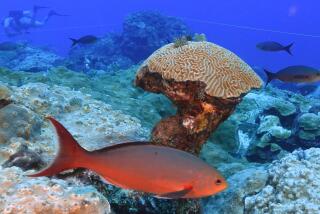New Life in a Dead Reef: Coral Mends Bones and Blocks Sun--for Starters : Ecology: Scientists are discovering human uses for calcified remains of marine animals.
- Share via
TOWNSVILLE, Australia — Snorkelers on a nature excursion watch marine biologist Gareth Johnstone skim past a giant clam and deftly pluck a small piece of coral from Australia’s Great Barrier Reef.
Swimming to the surface, he displays his trophy, which oozes clear mucus. “Something in this stuff and other parts of the coral protect it against the sun’s ultraviolet rays,” he says. “The substances someday may be useful as a sunscreen.”
Two coral experts--Bruce Chalker and Walter Dunlap at the Australian Institute of Marine Science, or AIMs, in Townsville--have synthesized and patented the protective chemicals. Some pharmaceutical companies soon may include them in sunscreens and cosmetics.
Coral reefs, found mostly in shallow temperate or tropical ocean waters, are the largest formations made on Earth by living organisms. They are the handiwork of small marine animals called polyps, which fashion limestone cups to protect their soft bodies. When these living bits of coral die, their calcified remains bond together, forming massive reefs.
The living organisms “are probably getting the highest dose of solar ultraviolet anywhere on the planet, with the exception of ice algae in the high alpine regions of the world, yet they thrive in it,” Chalker says.
But coral does a lot more than build reefs and produce sun block. One of its most important benefits is in helping to repair the human body. Doctors sometimes use coral as a bone substitute in reconstructive surgery.
The main advantage of the coral substitute, says Dr. Michael Chapman, an orthopedic surgeon at the University of California, Davis Medical Center, is that “we no longer have to harvest bone grafts from the patients themselves. This saves the patient discomfort and the complications associated with taking the graft.”
The interconnected pores of specially treated warm-water corals allow adjacent living bone to send new blood vessels and bone tissue into the coral maze, creating a strong bond of new bone.
David Mercer, president of Interpore International in Irvine, Calif., the only U.S. producer of coral for bone, estimates that his company imported about 6,000 pounds of coral in 1993. One coral head weighing 150 to 200 pounds provides enough material for hundreds of bone grafts.
Versatile coral shows promise for still other applications. It contains substances that may be effective food preservatives. And, like tree rings and ice cores, it harbors a record of former climates.
Through the centuries, coral picks up molecules of soil washed into the ocean by rivers. Drilling into the coral, extracting a core and then “reading” the fluorescent bands created by the molecules, scientists have tracked climatic conditions as far back as 1,000 years.
“We’ve perfected a set of instruments that allows us to read these beautiful fluorescent bands each year and in some places each month, back through the centuries,” says AIMS scientist Peter Isdile. “They tell us what sort of wet season, monsoon seas or drought that the river catchment incurred. So you can look at long sequences of dry years, large flood events and all sorts of mixtures.”
The instruments also can detect much older readings from ancient corals that are now buried in land formations. “We’ve reconstructed the climate of the Sinai Peninsula in the Middle East for the last 200,000 years,” Isdile says.
Unfortunately, some of coral’s remarkable properties lead to its destruction by humans. Live coral in some parts of the Indian Ocean is mined for the construction industry, which turns it into cement. “Most of the reefs around the Indian subcontinent are in real trouble,” says Clive Wilkinson, an AIMS research scientist.
Although destructive practices in many parts of the world can wipe out years of growth, coral often survives through its sexual prowess, as evidenced in a spectacular event involving at least half of the 350 coral species on the Great Barrier Reef every austral spring.
“This incredible mass spawning phenomenon, discovered only in 1982, is the corals’ main answer to the great problem of how to get sperm and eggs together from parents that are separated widely and that live in an environment of never-ending water movement,” reef biologist J. E. N. (Charlie) Veron writes in a book, “Corals of Australia and the Indo-Pacific.”
Mass coral spawning isn’t unique to Australian waters, even though it hasn’t been observed in great detail in other places. “We’re talking about a phenomenon that’s worldwide,” says Alina Szmant, a University of Miami marine biologist.
Since 1990, the same spawning behavior has been observed shortly after the August full moon on the Flower Garden Banks, the northernmost coral reefs on the continental shelf, in the northwestern Gulf of Mexico.






